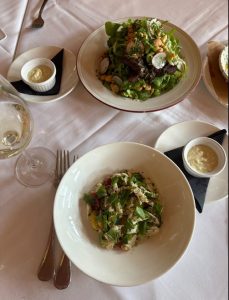NOLAbeings creator steps out from behind her camera
August 21, 2014
You might find Claire Bangser wandering the streets of the Marigny, talking to strangers and taking photographs. You might find her work, NOLAbeings, on your Facebook or Instagram newsfeed. NOLAbeings’ posts simply feature a photograph of a ‘being’ with a corresponding quote from the subject as the caption. Outside of a short blurb on her website, however, Bangser includes little information about her own identity. Bangser explained she would rather have the spotlight on the project and the people involved despite the challenges.
“As much as I can I am trying to keep this project not about me,” Bangser said. “I am all over it in the sense that I am taking the pictures and asking the questions, and I’m picking the quotes … but I don’t want it to become Claire’s portrait project.”
Despite telling the stories of so many others through this project, Bangser has never brought her own story to light. She actually hails from Connecticut and attended Washington University in St. Louis where she minored in Fine Arts. She has since bounced around the world, working at a maternal health program in Washington, earning a grant to photograph in Turkey through National Geographic’s Young Explorer program and finally taking a three-month bike tour through the Pacific Northwest. During this period, however, Bangser felt disconnected from her creative roots and decided to move into a friend’s closet in New Orleans.
NOLAbeings works as a photo portrait project in a clearly derivative fashion to Brandon Stanton’s Humans of New York project. Bangser does not hide this fact but rather embraces the similarities and highlights differences.
“[I] had never heard of HONY until February,” Bangser said. “Like three days after I heard of it, I’m like, I’m doing this in New Orleans.”
She would later start the project on a whim at Cafe Du Monde in the French Quarter. Stanton’s style combined storytelling and photography and provided accessible slices of life perfect for the current, internet-driven culture.
“It’s not the whole story, but just to give these snippets,” Bangser said. “A glimpse into someone else’s world shows the humanity that we are all going through the same types of things. We are all just learning how to figure it out and deal.”
In order to keep the project genuine, Bangser does not filter her photographs or quotes or shy away from possible negativity, even if it involves the city of New Orleans itself. Instead of covering only the happy and hopeful subjects, Bangser said she hopes to cover the whole spectrum of human emotion. Bangser’s portrait framing also greatly differs in style from Stanton’s. Instead of full-body portraits, Bangser focuses on closer shots and often focuses on the subject’s eyes.
She continued to highlight the differences between NOLAbeings and HONY, including the ability to create more of an environment within the photographs.
“It’s not just like a tan building in New York that could be any building,” Bangser said. “It’s like ‘Oh! That’s definitely the Marigny.’”
In a project dedicated to connecting with people, Bangser has seen her view of people change. Approaching strangers and speaking with them about personal aspects of their lives creates an immediately vulnerable environment. In her experience, however, Bangser said she has found that nearly nine out of every 10 people she approaches decide to participate in the interview.
“I think I’ve learned, people want to connect,” Bangser said. “I don’t just mean that when I go up to talk to people that they are interested in telling me things. I mean the community around NOLAbeings is growing, and I haven’t ever publicized it … we seek some context for ourselves when we connect with others. I hope that other people take from the project is this idea that they can talk to strangers more. That’s how I would define success.”









Leave a Comment